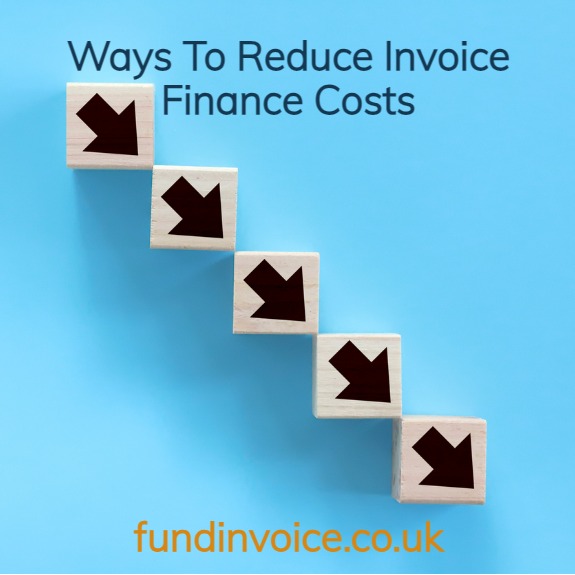
These Are 6 Ways to Reduce Your Invoice Finance Costs
Whether you already use invoice finance or are new to the market, you will want to know that you are getting the best deal possible. Therefore we have noted below 6 ways for you to save money and reduce the cost of invoice finance:
- Shop Around & Renegotiate - there are around 60 main invoice finance companies in the UK so there is plenty of choice and they are all keen to help new clients. You can SEARCH FOR INVOICE FINANCE QUOTATIONS without any obligation to proceed. It is a competitive market and a new provider will often offer you better rates than your current provider. Even if you don't want to switch providers, by knowing what is available in the market you can renegotiate terms with your existing provider.
- Consider Changing Products - Depending on whether you are currently using invoice discounting or factoring, you may be able to make a cost saving by switching products. If you are currently using a factoring facility, and you have existing resources within your business that could deal with credit control, it may be that you can save money on your invoice finance costs by switching to an invoice discounting facility where you do not receive a credit control collections service as part of the facility. Hence the facility may be cheaper. Alternatively, if you are currently using invoice discounting and you have existing credit control staff within your business, by switching to Factoring you will receive a credit control service as part of the facility and this may enable you to reduce your staffing cost by not employing credit control staff.
- Switch Between Whole Turnover And Selective Invoice Finance - Most factoring and invoice discounting facilities operate on what is known as a "whole turnover" basis. This means that all of your invoices are automatically captured under the invoice finance arrangement and the charges are likely to be determined as a percentage of the value of your invoicing. If you do not have a consistent requirement for cash within your business, for example, if you are subject to seasonal trading peaks and it is these that you require funding for, you may be better off considering a selective facility where you only factor or discount certain invoices, hence reducing the cost of the facility overall. Alternatively, if you are using selective invoice finance on a regular basis, a whole turnover facility could be a cheaper option.
-
Review Your Bad Debt Protection - If you already have bad debt protection as part of a factoring or invoice discounting facility, you should review the effectiveness of that cover. Consider how adequate your credit limits are that have been granted by your invoice finance company. Also, take into account any other provisions of the arrangement, such as first loss clauses which mean that you are not going to be covered for the first part of any particular loss. If you find that your bad debt protection is not providing you with adequate cover, you may wish to save some money on your invoice finance costs by moving to a recourse facility (where you do not receive bad debt protection).
-
Drive Down The "Other Costs" Associated With Some Invoice Finance Services - There are a number of other charges that may be applied by a factor or discounter. An example of this is if you take payments by CHAPS rather than BACS. A BACS transfer is often provided without charge, however, a BACS transfer will take longer to clear, and credit funds to your account, than a CHAPS transfer. If you are able to plan ahead, your cash flow requirements, you may be able to switch from using one to the other in order to reduce the cost associated with your facility. You should also review the other costs detailed on the statement provided by your invoice finance company (normally each month). You can identify the type of other charges that you are incurring and seek to drive them down. For example, if you are being charged re-factoring fees, in respect of overdue debts, it could be cost-effective to spend some time chasing these invoices yourself, in order to avoid paying these penalty fees or move to an invoice finance company that doesn't charge them.
-
Review Your Exclusions - Most invoice finance companies have the ability to exclude certain transactions from your invoice finance facility, even if it is operated on a whole turnover basis. For example, certain types of transactions may be of no interest to the factor so they may exclude them, which can also be known as "not notifying" those particular transactions. If you have specific, identifiable parts of your business's trading that you could manage without receiving funding against, e.g. particular customers or types of transactions, you might consider asking the invoice finance company to allow you to make those non-notifiable or excluded, under the terms of the facility. This may prevent you from needing to pay a fee in respect of those particular types of invoices. If you have a fully selective invoice finance facility, you can make these choices without needing to consult your provider.
This article was written by Glenn Blackman of FundInvoice LLP. FundInvoice publishes "FundingVoice" magazine and provides an independent quotation search service for invoice finance quotations without any obligation for you to proceed. To contact FundInvoice please follow this link: CONTACT FUNDINVOICE






